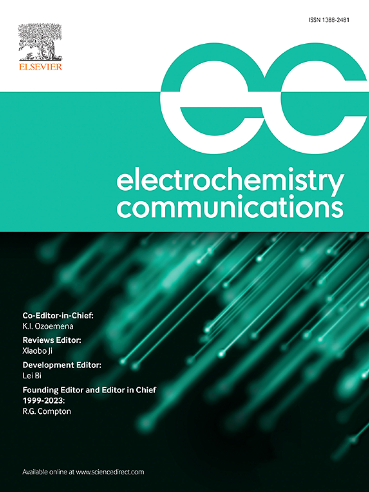Eco-friendly hydrothermal synthesis of Co3O4-based NiO–Fe2O3 binary and ternary nanocomposites for electrochemical energy storage applications
IF 4.2
3区 工程技术
Q2 ELECTROCHEMISTRY
引用次数: 0
Abstract
The increasing global demand for advanced energy storage technologies necessitates the development of high-performance materials. In this study, Co3O4-based NiO-Fe2O3 binary and ternary nanocomposites were synthesized via a green hydrothermal method using banana peel extract as a sustainable reducing agent. The Phase analysis, microstructural, elemental composition, electrochemical, and magnetic properties of synthesized materials were analyzed using X-ray diffractions (XRD), scanning electron microscope (SEM), energy dispersive x-rays (EDX), cyclic voltammetry (CV), electrochemical impedance spectroscopy (EIS), linear sweep voltammetry (LSV), and vibrating sample magnetometry (VSM) technique. XRD analysis confirmed the coexistence of binary (NiO-Co3O4) and ternary Fe2O3-NiO-Co3O4 phases in the nanocomposite. The surface morphology analysis showed the presence of spherical and round-like shape. Electrochemical analysis revealed a high specific capacity of 2692 mAh g−1 for the Fe2O3-NiO-Co3O4 nanocomposite, significantly surpassing the binary compound. The corresponding energy densities were 391.2, 363.2, 328.2 J/mA.cm−2, with Tafel slopes of 112, 129, and 118 mV/dec, respectively. The VSM results indicated retentivity values of 1.49, 2.53, and 1.03 emu/g for NiO/Co3O4, Fe2O3/Co3O4, and Fe2O3/NiO/Co3O4 nanocomposite. The energy dispersive x-rays (EDX) spectroscopy confirmed the presence of Co, O, Fe, and Ni elements. These findings highlight the potential of Co3O4-based NiO/Fe2O3 nanocomposites as promising candidates for high performance energy and data storage applications.
生态友好型水热合成co3o4基NiO-Fe2O3二元和三元纳米复合材料的电化学储能应用
全球对先进储能技术日益增长的需求要求高性能材料的发展。本研究以香蕉皮提取物为可持续还原剂,采用绿色水热法制备了co3o4基NiO-Fe2O3二、三元纳米复合材料。采用x射线衍射(XRD)、扫描电镜(SEM)、能量色散x射线(EDX)、循环伏安法(CV)、电化学阻抗谱(EIS)、线性扫描伏安法(LSV)和振动样品磁强计(VSM)技术对合成材料的物相分析、微观结构、元素组成、电化学和磁性能进行了分析。XRD分析证实了复合材料中存在二元(NiO-Co3O4)相和三元Fe2O3-NiO-Co3O4相。表面形貌分析显示为球形和圆形。电化学分析表明,Fe2O3-NiO-Co3O4纳米复合材料的比容量高达2692 mAh g−1,明显优于二元化合物。对应的能量密度分别为391.2、363.2、328.2 J/mA。cm−2,塔菲尔斜率分别为112、129和118 mV/dec。VSM结果表明,NiO/Co3O4、Fe2O3/Co3O4和Fe2O3/NiO/Co3O4纳米复合材料的保留率分别为1.49、2.53和1.03 emu/g。能量色散x射线(EDX)光谱证实了Co, O, Fe和Ni元素的存在。这些发现突出了基于co3o4的NiO/Fe2O3纳米复合材料作为高性能能源和数据存储应用的有希望的候选者的潜力。
本文章由计算机程序翻译,如有差异,请以英文原文为准。
求助全文
约1分钟内获得全文
求助全文
来源期刊

Electrochemistry Communications
工程技术-电化学
CiteScore
8.50
自引率
3.70%
发文量
160
审稿时长
1.2 months
期刊介绍:
Electrochemistry Communications is an open access journal providing fast dissemination of short communications, full communications and mini reviews covering the whole field of electrochemistry which merit urgent publication. Short communications are limited to a maximum of 20,000 characters (including spaces) while full communications and mini reviews are limited to 25,000 characters (including spaces). Supplementary information is permitted for full communications and mini reviews but not for short communications. We aim to be the fastest journal in electrochemistry for these types of papers.
 求助内容:
求助内容: 应助结果提醒方式:
应助结果提醒方式:


